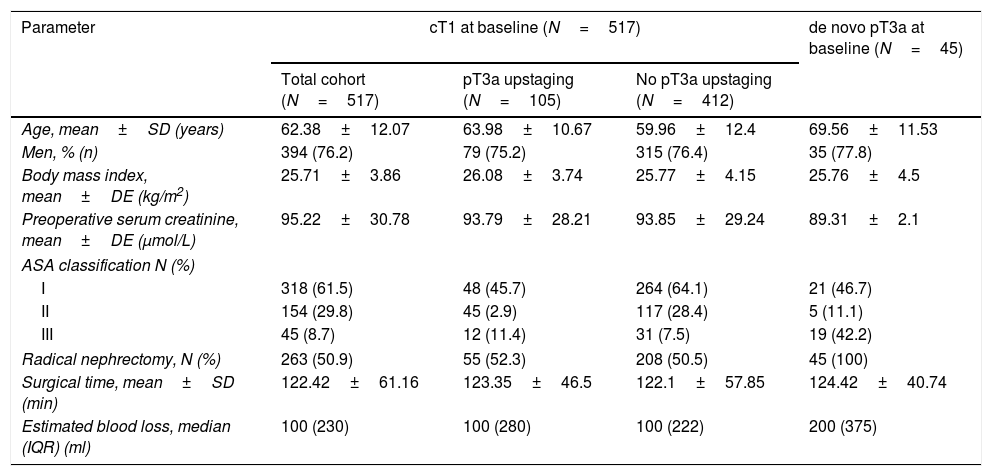The significance of upstaging of cT1 renal tumors to pT3a is not clear. We evaluate the incidence of upstaging, identify predictors and analyze oncological outcomes of these patients versus those who did not upstage. We also compared the oncological outcomes of cT1 upstaging to pT3a with de novo pT3a renal tumors.
MethodsFrom a database of 1021 renal tumors with complete available follow-up data, 517 patients had cT1. Patients upstaging to pT3a were compared to those who did not. Baseline clinical, perioperative, histopathologic features and oncological outcomes were analysed.
ResultsOut of 517 cT1 patients, 105 (20.3%) upstaged to pT3a and 412 (79.7%) did not. Proportion of patients in each group undergoing partial and radical nephrectomy, postoperative tumor size, histology, margin status and lymph node involvement were similar. Among upstaged, 9 patients (8.6%) developed first recurrence as compared to only 3 (0.7%) in those not upstaging (p<0.001). The median time to recurrence (57 vs. 107 months; p<0.001) was lesser in de novo pT3a renal tumors.
ConclusionsPathological upstaging from cT1 to pT3a and necrosis on histopathology were associated with recurrence.
Advanced age, smoking, necrosis on histopathology, clear cell histology and higher Fuhrman grades contributed to pathological upstaging of cT1 tumors. De novo pT3a RCC had worse survival when compared to cT1 patients upstaging to pT3a RCC.
La importancia de la sobrestadificación de tumores renales cT1 a pT3a no está clara. Evaluamos la incidencia de la sobrestadificación, identificamos factores predictivos y analizamos los resultados oncológicos de estos pacientes frente a aquellos que no sobrestadificaron. También comparamos los resultados oncológicos de la sobrestadificación de cT1 a pT3a con tumores renales pT3a de novo.
MétodosDe una base de datos de 1.021 tumores renales con datos de seguimiento completos disponibles, 517 pacientes tenían cT1. Los pacientes que sobrestadificaron a pT3a se compararon con aquellos que no lo hicieron. Se analizaron los resultados de las características clínicas, perioperatorias, histopatológicas y oncológicas iniciales.
ResultadosDe 517 pacientes con cT1, 105 (20,3%) sobrestadificaron a pT3a y 412 (79,7%) no lo hicieron. La proporción de pacientes en cada grupo tratados mediante nefrectomía parcial y radical, el tamaño del tumor postoperatorio, la histología, el estado de los márgenes, y la afectación de ganglios linfáticos fueron similares. Entre los que sobrestadificaron, 9 pacientes (8,6%) desarrollaron la primera recurrencia en comparación con solo 3 (0,7%) en aquellos que no sobrestadificaron (p<0,001). La mediana del tiempo hasta la recurrencia (57 frente a 107 meses; p <0,001) fue menor en los tumores renales pT3a de novo.
ConclusionesLa sobrestadificación patológica de cT1 a pT3a y la necrosis en la histopatología se asociaron con la recurrencia. La edad avanzada, el tabaquismo, la necrosis en la histopatología, la histología de células claras y grados más altos de Fuhrman contribuyeron a la sobrestadificación patológica de los tumores cT1. El CCR pT3a de novo tuvo una supervivencia peor cuando se comparó con los pacientes con cT1 que sobrestadificaron a CCR pT3a.











